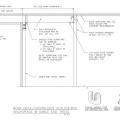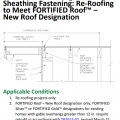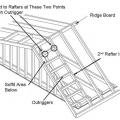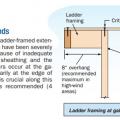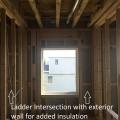Scope
Construct framing at gable roof overhangs that is resistant to wind uplift forces during hurricanes or other storms. This guide describes two common gable overhang construction methods, ladder framing and outrigger framing, with a focus on applications in coastal high-wind areas.
- If the house is in a hurricane-prone region or other high-wind area, determine the framing approach based on the length of the gable roof overhang.
- Ladder framing and outrigger framing are the two most common methods.
- Outrigger framing, using outlookers, is recommended for overhangs greater than 12 inches deep.
- Install gable roof overhang framing with correct lumber dimensions using adequate connections.
- Attach fascia board at the edge of the overhang.
- Install roof deck sheathing extended over the gable framing and installed with correct fasteners and fastener pattern.
- Install a rigid soffit material such as structural sheathing plywood or OSB to cover the underside of the overhang.
See the Compliance Tab for links to related codes and standards and voluntary federal energy-efficiency program requirements.
Description
Gable roof overhangs provide shading and protection from the elements and can also be considered desirable aesthetically. The gable roof overhang reduces the amount of rain that hits the exterior of the home, thus providing additional protection from water damage. It also protects doors and entryways, provides shade to windows, and protects the foundation from excess water runoff, which helps to keep the basement and crawlspace dry. Although an important structure of the house, it is also one of the most vulnerable components during high-wind events.
During a hurricane, tornado, or high winds, gable roof overhangs are subject to significant uplift pressures (Figure 1) and can be damaged or blown off, leading to severe damage to the roof and other structural members of the house. The exposed roof can allow rainwater to enter the building, causing severe damage including saturation of insulation and ceiling drywall, potentially leading to collapsed ceilings and extensive damage to interior finishes and household contents.
Two common methods of framing gable roof overhangs are ladder framing and outrigger framing. New construction and roof retrofits are opportunities to upgrade the gable roof overhang to meet standards and building codes and to decide if selecting an above-code strategy for an added level of protection is the right choice for the project.
Ladder framing is constructed using two long parallel boards that are connected by short blocks, like the rungs of a ladder. This framing is attached by nailing through the gable wall sheathing into the last truss or rafter. Roof sheathing is installed above the overhang and provides structural support and resistance to wind uplift. Ladder framing is typically limited to shorter overhangs of 8 to 12 inches.
Outrigger framing is typically used for overhangs greater than 12 inches. The size of the gable truss or rafter or truss is adjusted such that the top level of the end truss or rafter is less than the top level of the rest of the trusses or rafters to provide enough space for the outriggers to pass above the end rafter or truss. Outriggers, which may be 2x4 members or 2x6 members, are then installed on top of the gable truss or rafter so that they butt up against the truss or rafter next to the gable truss and extend outwards to support a fascia board along the edge of the overhang. See Figures 2 and 3.

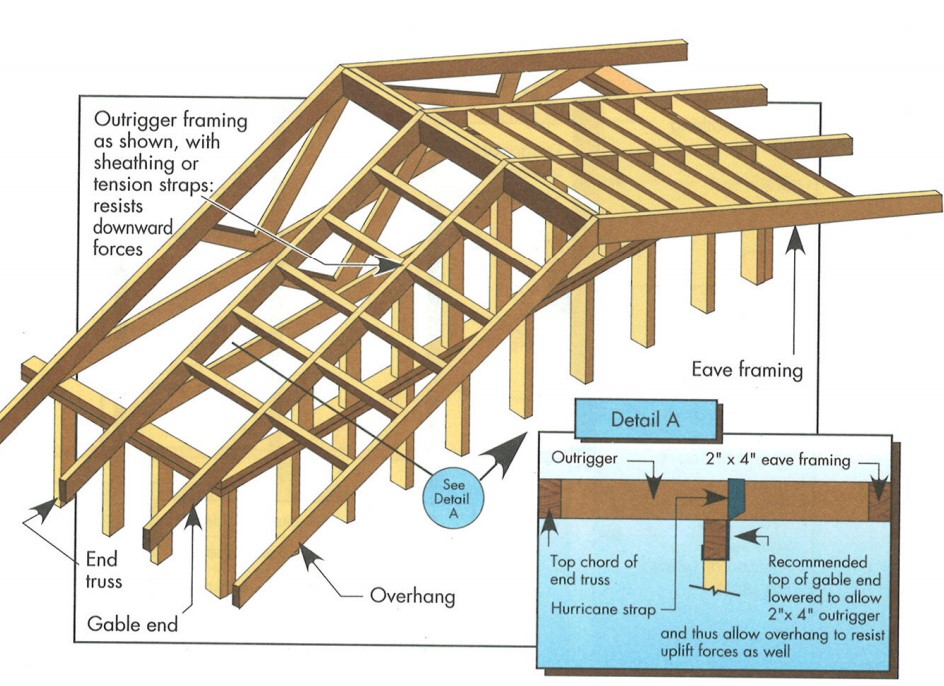
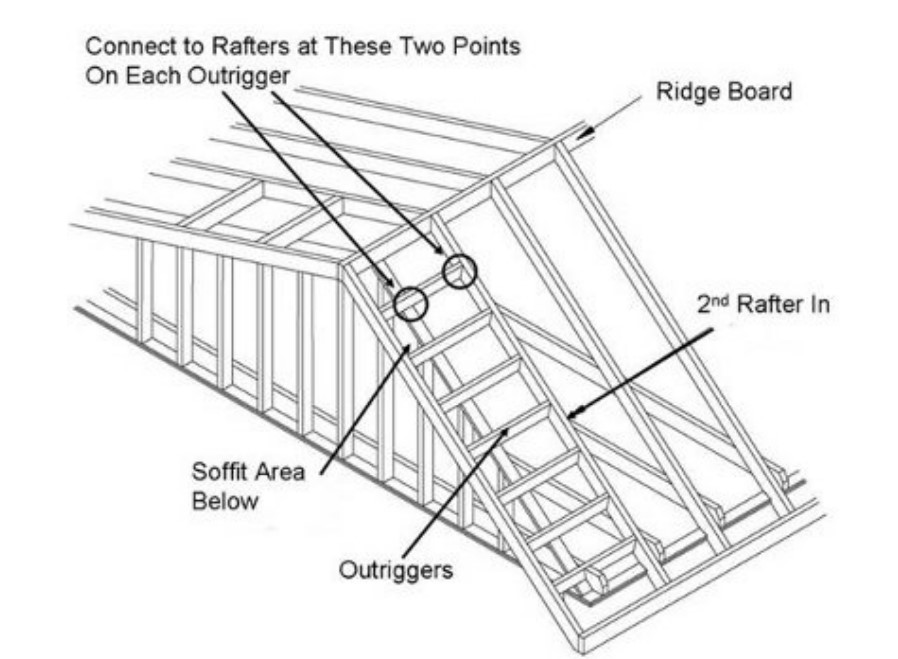
The International Residential Code (IRC) requires exterior building components and their attachments to be capable of resisting design wind-pressures. For some high-wind regions, the IRC requires wind design in accordance with other methods including the International Building Code (IBC). Homes located in coastal high-wind areas including Hurricane-Prone Regions generally require enhanced attachment that can withstand greater wind speeds than the rest of the country. The IRC defines Hurricane-Prone Regions as areas along the Atlantic and Gulf Coasts where wind velocity is >115 mph, and Hawaii, Puerto Rico, Guam, the Virgin Islands, and American Samoa (see the IRC wind map in the Climate tab). Confirm with the local building department if the house is in a hurricane-prone region and if local requirements exceed those of the IRC.
The IRC specifies minimum requirements for continuous roof sheathing at gable end walls, including fastener (nail) type, spacing, and penetration depth into structural members. (See the Compliance tab for details).
The Insurance Institute for Business and Home Safety® (IBHS) offers guidance, best practices, and voluntary construction standards and programs for building in disaster-prone areas including hurricane and high-wind zones. The IBHS FORTIFIED HOME™ standard is designed to make homes more resilient and durable; guidance is available for New Construction and Existing Homes in Hurricane zones and High-Wind zones. There are three levels of FORTIFIED Home: FORTIFIED Roof™ focuses on the roof; FORTIFIED Silver focuses on roof overhangs, opening protection, gable ends, and attached structures; FORTIFIED Gold focuses on tying all components of the structure together.
The FORTIFIED Home Hurricane Standard requires gable end overhangs to be attached to gable framing and constructed to resist wind uplift force. When overhangs exceed 12 inches, most IBHS standards require additional members or outlookers to support the overhang sheathing. Outlookers are framing members that extend to the top of the gable end wall to support the roof deck overhang and are oriented with their larger dimension perpendicular to the roof sheathing. FORTIFIED Home Hurricane Standards require these outlookers to be adequately sized, spaced, and attached to the supports to prevent any failure. It also requires the gable end soffits to be unvented since gable end soffits are susceptible to wind-driven water intrusion because of the large amount of water that accumulates on the gable wall when it faces into the wind.
The Federal Emergency Management Agency (FEMA) recommends a maximum of 8 inches of gable roof overhang and a maximum of 4 inches on center fastener spacing for ladder framing in high wind regions. It also requires the spacing of the overhangs to be not more than 24 inches on center and the overhangs at gable end wall framing or truss framing should not be notched.

How to Install Ladder Framing
- Select 2x4 or 2x6 lumber or as specified by the design.
- Mark the 2x lumber at 24-in. on-center, or as specified in design, to locate the blocking.
- Calculate the length of blocking by subtracting the thickness of the 2x lumber forming the outer framing of the ladder overhang. The total length of the overhang should be 12 inches or less.
- Fasten the blocking at the marks to form a ladder-like assembly using 8d nails.
- Attach the ladder assembly to the gable wall frame using #10, 4-inch deck screws with 1.5-in. diameter washers at 6 inches on-center and 3 inches from each end of the ledger.
- Attach a minimum 2x6 fascia board along the edge of the overhang using #10, 3-inch deck screws with 1.5-inch diameter washers at 8 inches on-center and 3 inches from each end of the fly rafter.
- Install roof decking that covers the gable overhang framing and extends at least 24 inches in from the gable wall over the roof trusses or rafters. Nail the roof deck to the fascia and rafters using 8d ring shank nails at 4 inches on-center with a minimum penetration of 1-5/8 inches.
- Use 7/16-in. structural sheathing (plywood or OSB) to cover the underside of the overhang using 8d nails at 3 inches on center at each end.
How to Install Outrigger Framing:
- Select 2x4 or 2x6 lumber or as specified by the design.
- Mark along the rafter or truss next to the rafter or truss on the gable end at 12 inches on center.
- Install outriggers so that they butt against the rafter or truss next to the rafter or truss on the gable end and pass above the rafter or truss on the gable end using a straddle-type hurricane strap and suitable fasteners.
- Attach a minimum 2x6 fascia board along the edge of the overhang using #10, 3-inch deck screws with 1.5-inch diameter washers at 8 inches on-center and 3 inches from each end of the fly rafter.
- Install roof decking that covers the gable overhang framing and extends at least 24 inches in from the gable wall over the roof trusses or rafters. Nail the roof deck to the fascia and rafters using 8d ring shank nails at 4 inches on-center with a minimum penetration of 1-5/8 inches.
- Use 7/16-inch structural sheathing (plywood or OSB) to cover the underside of the overhang using 8d nails at 3 inches on-center at each end.
| Wind Speed (mph) | Exposure B | Exposure C | Exposure D | |
|---|---|---|---|---|
| ASCE 7-10 Ultimate | ASCE 7-05 Allowable | Suburban, Residential, inches | Bay Font, Open Terrain, inches | Oceanfront Only, inches |
| 130 | 101 | 24 | 24 | 24 |
| 140 | 108 | 24 | 24 | 24 |
| 150 | 116 | 24 | 24 | 22 |
| 160 | 124 | 24 | 24 | 18 |
| 170 | 132 | 24 | 20 | 14 |
| 180 | 139 | 24 | 20 | 14 |
Success
Determine if local building codes have specific additional requirements for framing gable roof overhangs. For disaster resistance, comply with the roofing requirements defined by the IBHS Fortified Home program (Fortified Technical Resources)
Climate
The International Residential Code (2018) requires the roofing members to be designed in accordance with the minimum live loads table (see below) or the snow load table provided in the IRC (2018 IRC, Table R301.2(1)).
Table 1. Minimum Roof Live Loads in Pounds-Force per Square Foot of Horizontal Projection. (2018 IRC, Table R301.6).
| Roof Slope | Tributary Loaded Area in Square Feet for Any Structural Member | ||
0 to 200 | 201 to 600 | Over 600 | |
| Flat or rise less than 4 inches per foot (1:3) | 20 | 16 | 12 |
| Rise 4 inches per foot (1:3) to less than 12 inches per foot (1:1) | 16 | 14 | 12 |
| Rise 12 inches per foot (1:1) and greater | 12 | 12 | 12 |
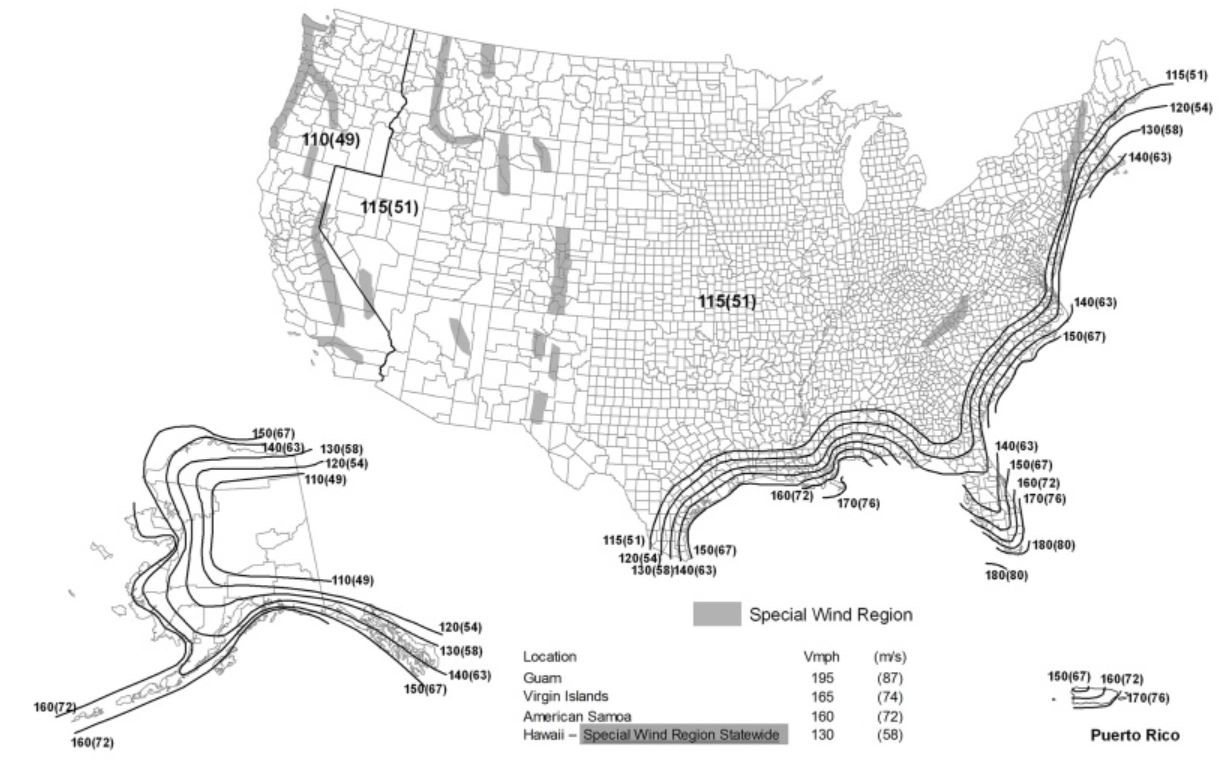
The Insurance Institute for Business and Home Safety® (IBHS) offers guidance, best practices, and voluntary construction standards and programs for building in disaster-prone areas including hurricane and other high-wind zones. The IBHS FORTIFIED Roof™ program includes guidance on sealed roof decks, flashing, and shingle attachment.
Training
Compliance
Retrofit
Select framing members that are at least 2x4s for gable end overhang retrofits. The members should be spaced no greater than 24 inches on center. The outlookers and gable end wall framing or truss framing should not be notched.
In order to retrofit the overhangs at gable ends, add a saddle type hurricane clip to connect the overhang to the gable end wall/truss (see Figures 1, 2, and 3 below). Also add a joist hanger to secure the overhang member to the roof framing member. Complete the retrofit before the roof sheathing is strengthened.
Figure 3 shows the following details:
- 7/16-in. structural sheathing (plywood or OSB) fastened to 2- x 4-in. ledgers with 8d nails at 3 in. o.c. at each end. Provide 2- x 4-in. blocking at all soffit panel joints.
- 2x4-in. continuous ledger fastened to wall framing through exterior sheathing with #10 x 4-in.- long deck screw and a 1.5-in.-diameter washer at 6 in. o.c and 3 in. from each end of the ledger.
- 2x4-in. continuous ledger fastened to 2x6-in. fascia with #10 x 3-in.-long deck screw and a 1.5-in.-diameter washer at 8 in. o.c. and 3 in. from each end of the ledger.
- 2x minimum fascial board.
- Nail the roof deck to the fascia and first and second rafters with 8d ring shank nails at 4-in. o.c. (minimum 1 5/8-in. penetration).
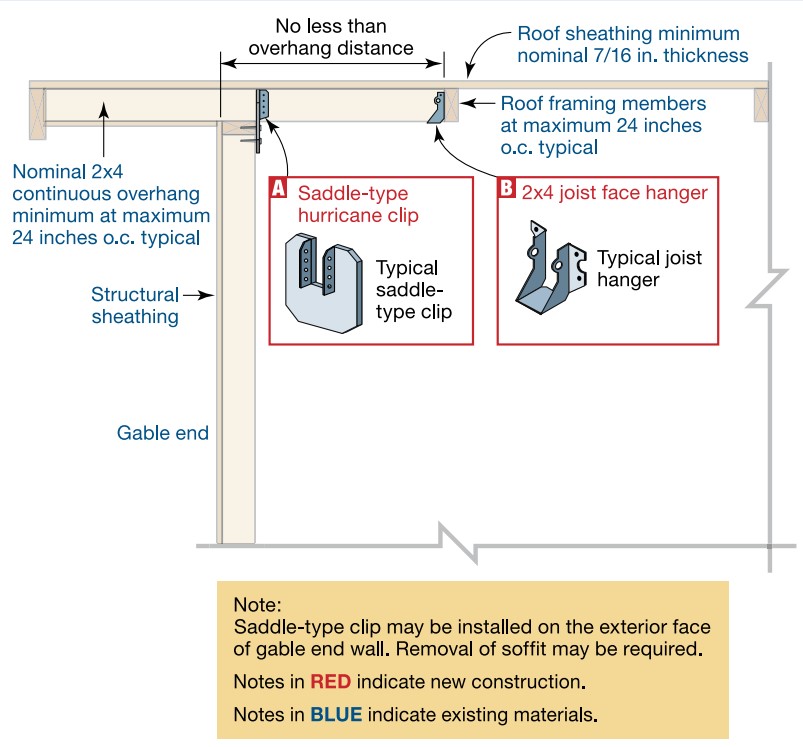
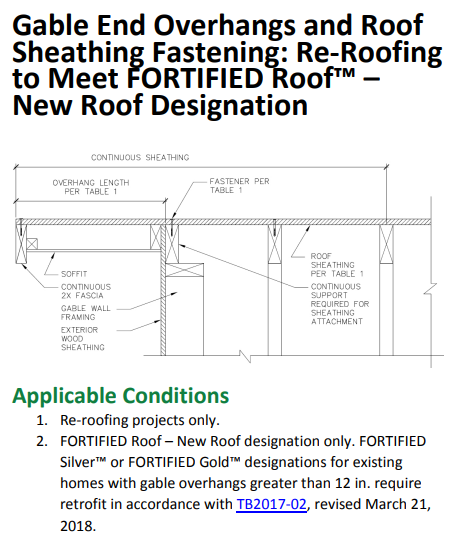
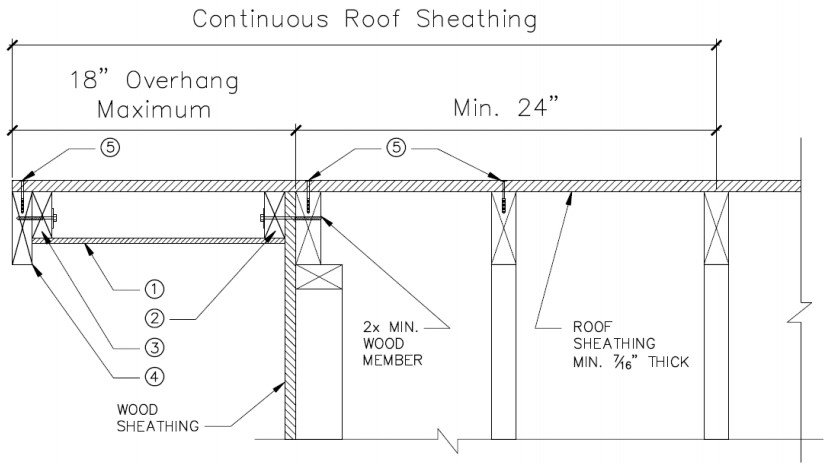
More
More Info.
Access to some references may require purchase from the publisher. While we continually update our database, links may have changed since posting. Please contact our webmaster if you find broken links.
The following authors and organizations contributed to the content in this Guide.

